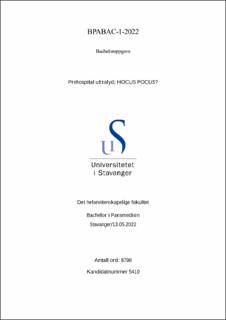| dc.contributor.advisor | Sollid, Stephen Johan Mikal | |
| dc.contributor.author | Grassdal, Øyvind | |
| dc.date.accessioned | 2022-07-16T15:52:15Z | |
| dc.date.available | 2022-07-16T15:52:15Z | |
| dc.date.issued | 2022 | |
| dc.identifier | no.uis:inspera:111413766:49568831 | |
| dc.identifier.uri | https://hdl.handle.net/11250/3006091 | |
| dc.description.abstract | Sammendrag
Bakgrunn og hensikt:
De siste seks tiårene har ambulansetjenesten utviklet seg fra å være en enkel transporttjeneste til å bli en viktig del av den akuttmedisinske kjeden. Stadig mer behandling og undersøkelser gjøres prehospitalt, og ultralyd omtales som det nye stetoskopet. Samtidig slås det fast i NOU 17:2015 Først og fremst, at ambulansepersonell trenger økt kompetanse for å bruke ultralyd ved akuttmedisinske tilstander og skader. Hensikten med denne studien er å undersøke om ambulansepersonell har god nok kunnskap til å tilegne seg, samt bruke POCUS som beslutningsstøtteverktøy på selvstendig grunnlag.
Metode
Jeg har benyttet systematisk litteraturstudie som metode. Det er søkt i databasen Cinahl og søkemotoren PubMed, samt usystematisk i Google Scholar. Jeg inkluderte studier fra 2010 til dags dato.
Resultat
Det ble inkludert tre artikler fra PubMed, to fra Cinahl og én ble identifisert gjennom snøballmetoden. Tre av studiene var relatert til simulering, og tre inkluderte pasienter. Artiklene konkluderer med at ambulansepersonell kan, etter kort fokusert opplæring, tilegne seg tilfredsstillende kunnskaper og ferdigheter til å bruke POCUS. Ingen artikler har oppnådd statistisk signifikans.
Diskusjon og avslutning
Å forske i et prehospitalt miljø er krevende og medfører at det må tas hensyn til mange ulike faktorer og variabler rundt studiedesign, deltakere, vurdering av samtykke og andre etiske problemstillinger. På grunn av lavt antall deltakere, både pasienter og ambulansepersonell, kan en ikke generalisere og konkludere med statistisk signifikans. Likevel tyder funnene på at ambulansepersonell har faglige forutsetninger for å mestre POCUS og bruke det som beslutningsstøtteverktøy, men det trengs ytterligere forskning. | |
| dc.description.abstract | Abstract
Background and aim:
In the last six decades, the ambulance service has developed from being a simple transportation service to becoming an important part in the chain of emergency care. Paramedics are treating and examining more patients prehospitally now than ever, and there is a rapid technological evolution. Ultrasound is referred to being the new stethoscope, but at the same time it is stated in Official Norwegian Reports, NOU 17: 2015 Først og fremst, that paramedics need more education and competence to manage ultrasound in emergency medical conditions and trauma. The aim of this study is to investigate whether paramedics already have enough knowledge to acquire and use POCUS independent as a decision-making tool.
Method
The method of this study is systematic literature review. I used the search engine PubMed and the Cinahl database. I also made an unsystematically search in Google Scholar. The included studies were all released after 2010.
Result
Three articles from PubMed were included, two from Cinahl and one was identified through snowballing. Three of the studies were related to simulation, and three included patients. The articles conclude that paramedics can, after a brief, focused educational intervention, acquire satisfactory knowledge and skills to use POCUS. No articles have achieved statistical significance.
Discussion and conclusion
Researching in a prehospital environment is difficult because of its many different factors and variables, and this must be considered with regard to study design, participants, assessment of consent and more. Due to the low number of participants, both patients and paramedics, one cannot generalize and conclude with statistical significance. Nevertheless, the findings suggest that paramedics have the professional prerequisites to master POCUS and use it as a decision-making tool, but further research is needed. | |
| dc.language | nob | |
| dc.publisher | uis | |
| dc.title | Prehospital ultralyd; HOCUS POCUS? | |
| dc.type | Bachelor thesis | |
